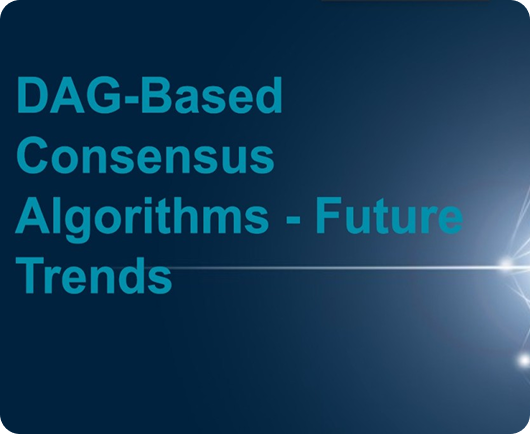DAG-Based Consensus Algorithms - Future Trends
DAG (Directed Acyclic Graph)-based consensus algorithms represent a novel class of consensus mechanisms in distributed ledger technologies. Unlike traditional blockchain structures, which follow a linear sequence of blocks, DAG-based systems allow multiple blocks (or transactions) to be published and recorded concurrently. This structure aims to improve scalability, transaction throughput, and confirmation times.

Overview of DAG-Based Consensus
DAG-based consensus replaces the single linear chain model with a directed acyclic graph of transactions (or blocks). Multiple transactions can be appended concurrently and reference other transactions as parents — enabling parallelism and higher throughput. The following sections describe structure, examples, benefits, challenges, and a simplified technical implementation.
Structure and Design
- DAG vs Blockchain: In a blockchain, transactions are grouped into blocks that form a single chain. In a DAG, individual transactions (or small units) reference previous transactions directly, forming a graph that grows in multiple directions rather than as a single linear chain.
- Concurrency & Parallelism: Because multiple transactions can be added at once and reference different tips, the network can process transactions in parallel, improving throughput and lowering per-transaction latency.
Examples of DAG-Based Protocols:
1. IOTA’s Tangle: IOTA uses a DAG structure called the Tangle, where each new transaction must approve two previous transactions. This design eliminates the need for miners and aims for fee-less transactions.
- Byteball: Utilizes a DAG where transactions are linked to each other, and consensus is reached through witnesses that validate the order of transactions.
Nano: Implements a block-lattice structure where each account has its own blockchain (account-chain) and consensus is achieved through voting on conflicting transactions.
Benefits of DAG-Based Consensus
- Scalability: The parallel processing capability of DAGs significantly increases transaction throughput, making the network more scalable compared to traditional blockchains.
- Lower latency: Transactions can be confirmed faster because they do not need to be grouped into blocks and mined. Each transaction can confirm previous transactions, leading to quicker finality.
- Low fees & microtransactions: Lightweight DAG designs often support low-cost or fee-less transfers suitable for micro-payments.
- Energy efficiency: Many DAG-based systems aim to eliminate or reduce transaction fees, making micro-transactions and high-frequency trading economically viable.
- Flexible design space: DAG-based systems can potentially achieve higher levels of decentralization as they do not rely on a small number of miners or validators. Each participant in the network can contribute to the consensus process.
Challenges and Considerations
- Security: DAG-based systems must address potential security vulnerabilities such as double-spending attacks and network splits. Mechanisms for achieving consensus and maintaining network integrity are critical. For instance, IOTA’s Tangle uses a Coordinator node to protect against attacks, but this introduces a degree of centralization.
- Complexity: The parallel nature and lack of a single, linear chain in DAGs make them more complex to implement and understand compared to traditional blockchains.
- Adoption and Maturity: DAG-based technologies are relatively new and less battle-tested compared to blockchain systems like Bitcoin and Ethereum. Widespread adoption and trust in these systems are still developing.
Technical Implementation of a DAG-Based Consensus Algorithm
Here is a simplified outline of how a DAG-based consensus algorithm like IOTA’s Tangle might work:
- Transaction Creation: A new transaction is created by a user. This transaction includes a reference to one or more previous transactions, effectively approving them.
- Transaction Validation: The new transaction undergoes validation to ensure it follows the network’s rules and does not conflict with existing transactions. Validation may include proof of work or other mechanisms to prevent spam.
- Transaction Confirmation: Once validated, the new transaction is added to the DAG, referencing the approved transactions. This process helps to confirm the transactions referenced by the new one.
- Consensus Achievement: Consensus is achieved as more transactions are added to the DAG, with each new transaction approving previous ones. The weight or trustworthiness of transactions increases as they receive more approvals.
Conclusion
DAG-based consensus algorithms represent an innovative approach to distributed ledger technology, offering significant advantages in terms of scalability, speed, and cost. However, they also come with challenges that need to be addressed, particularly around security and complexity. As the technology matures, DAG-based systems may play a crucial role in the future of decentralized networks, providing a viable alternative to traditional blockchain architectures.
